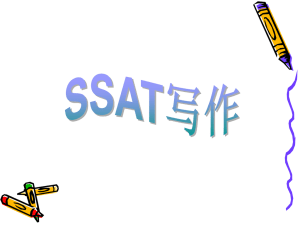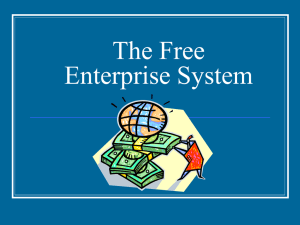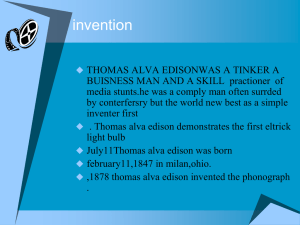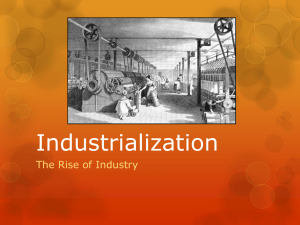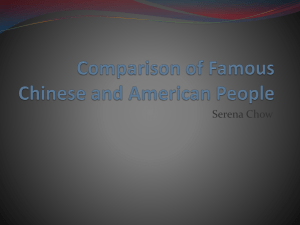SCE Customer Generation Presentation
advertisement
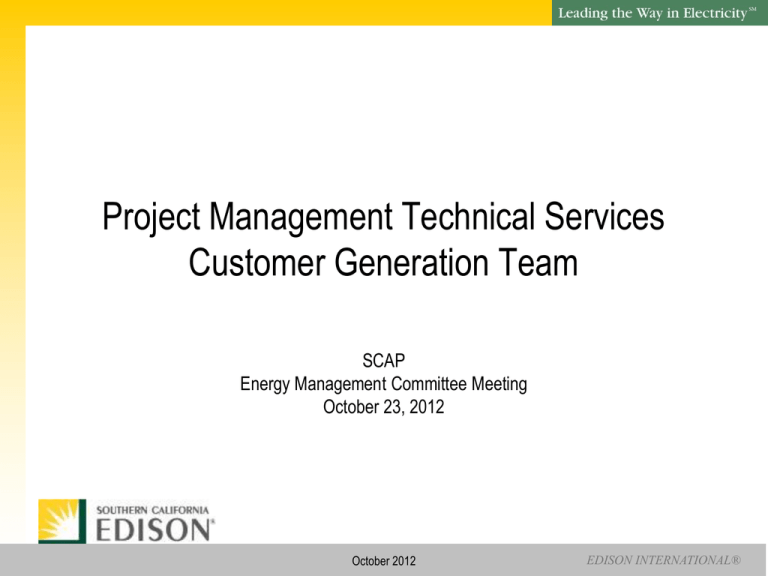
SM Project Management Technical Services Customer Generation Team SCAP Energy Management Committee Meeting October 23, 2012 October 2012 EDISON INTERNATIONAL® SM Overview • Customer Generation Team Introduction • Interaction with Account Managers/Account Executives and Customers • Generation Technologies Workshop • Recap Page 2 October 2012 EDISON INTERNATIONAL® SM Customer Generation Team • Project Managers – Bob Sliwoski (Lead) - Pax 42631 Page 3 – Eugene Sedeno - Office 1(760) 951-3132 – Russ Lieu - Pax 43045 October 2012 EDISON INTERNATIONAL® SM Customer Generation Team Activities • Provide education on alternate technologies and associated rules and tariffs to employees, customers, and community groups. – Perform engineering economic analyses on customer generation projects, at customer request. – Provide presentation support to clients and customers. – Provide technical expertise and engineering economic analyses for internal SCE programs and organizations, such as Customer Energy Efficiency & Solar (CSI, SGIP and NEM programs), Renewable and Alternative Power (RAP), and Energy Supply & Management (ES&M). • Provide technical expertise on regulatory and legislative proceedings to help shape outcomes that may impact our customers and/or the company. – Identify regulatory/legislative impacts and educate clients and customers. Page 4 October 2012 EDISON INTERNATIONAL® SM Account Manager/Executive Role • Identify and monitor customer generation interest and activity • Facilitate exchange of information • Assist customer’s decision process • Track progress by creating and updating Customer Care Self-Generation Opportunity in CRM (Customer Relationship Management) system Page 5 October 2012 EDISON INTERNATIONAL® SM Customer Generation Team Role • Meet with customers to identify needs • Obtain copy of generation proposals, and Power Purchase Agreements • Perform Engineering & Economic Analysis • Meet with customer and Account Mgrs/Execs to present analysis, risks, and benefits Page 6 October 2012 EDISON INTERNATIONAL® SM When Should Account Management Contact Us? • Examples of when Account Management should contact us: – Does the customer have significant interest in Self Generation? – Does the customer have a corporate initiative to “go green” by installing renewable generation? – Is the customer discussing Self Generation with vendors? – Is the customer inquiring about rebates (Self Generation Incentive Program and California Solar Initiative)? – Is the customer receiving proposals for self-generation? • Important Reminders: – The Customer Generation team cannot perform Engineering Economic Analyses if the customer has a signed contract or letter of intent (LOI) – Customer must provide a copy of the generation proposal before work can begin Page 7 October 2012 EDISON INTERNATIONAL® SM Customer Meeting with Self-Generation Decision Makers • Provides Opportunity to Discuss: – – – – – Current customer needs and issues Details of customer’s operation Tariff changes/issues Generation costs, risks, and benefits Energy Efficiency programs and incentives • More Important Reminders: – SCE is neutral overall regarding Self Generation – SCE does not promote or discourage Self Generation – SCE recommends that customers pursue EE/DR first Page 8 October 2012 EDISON INTERNATIONAL® SM Results of Engineering & Economic Analysis • • • • • Page 9 Identify economics of generation Detail generation alternatives Facilitate customer decision process Reveal underlying issues and needs Dispel misleading information October 2012 EDISON INTERNATIONAL® SM Generation Technologies Workshop October 2012 EDISON INTERNATIONAL® SM Overview • Introduction • Generation Technologies – Applications – Economics – Performance • Incentive programs Page 11 October 2012 EDISON INTERNATIONAL® SM Self Generation • Electric generation with no heat recovery Natural Gas Electricity Utility Distribution System Page 12 October 2012 EDISON INTERNATIONAL® SM Cogeneration • Electric generation plus heat recovery Natural Gas Electricity Steam or Hot Water Utility Distribution System Page 13 October 2012 EDISON INTERNATIONAL® SM Distributed Generation Technologies • • • • • • • Page 14 Internal Combustion Engines Small Gas Turbines Microturbines Fuel Cells Photovoltaics Wind Turbines Waste Heat Recovery-Generation October 2012 EDISON INTERNATIONAL® SM Distributed Generation Technologies • Internal Combustion Engines • • • • • • • Page 15 October 2012 IC Engines are derived from industrial diesel and automotive type engines Most mature of all DG technologies Range in size from 100 kW to 3,000 kW High potential for emergency standby Easily fueled by diesel, natural gas, or biogas Installed costs range $1,500-$2,500/kW Heat Rate at full capacity 9,400-14,000 Btu/kWh EDISON INTERNATIONAL® SM Distributed Generation Technologies • Small Gas Turbines Page 16 • A small gas turbine is essentially a small jet aircraft engine • Range in size from 1,200 kW to 10,000 kW • Installed costs range $1,300-$1,800/kW • Heat Rate at full capacity 10,000-15,000 Btu/kWh October 2012 EDISON INTERNATIONAL® SM Distributed Generation Technologies • Microturbines Page 17 • Same principle as small gas turbines • Range in size from 30 to 250 kW • High potential for cogeneration • Installed costs range $2,500-$3,000/kW • Heat Rate at full capacity 11,500-15,000 Btu/kWh October 2012 EDISON INTERNATIONAL® SM Distributed Generation Technologies • Fuel Cells • • • • • • • Page 18 October 2012 Operating principle is conversion of chemical energy to electrical energy Energy conversion using fuel such as hydrogen and natural gas without a combustion process Environmentally benign Range in size from 200 to 2,800 kW (typical installation – may be stacked to configure any desired size) Potential for cogeneration Installed costs range $6,000-$8,500/kW Heat Rate at full capacity 8,000-9,500 Btu/kWh (most efficient DG Technology) EDISON INTERNATIONAL® SM Distributed Generation Technologies • Photovoltaics • • • • • • Page 19 October 2012 Operating principle is conversion of sunlight directly to electricity Simple off-grid systems include PV modules, batteries, mounting structure, and associated wiring Environmentally benign Range in size from 10 to 1,000 kW (typical installation – modules may be linked to configure any desired size) No cogeneration potential Installed costs range $4,500-$7,500/kW EDISON INTERNATIONAL® SM Distributed Generation Technologies • Wind Turbines • • • • • Page 20 October 2012 Operating principle is conversion of the wind’s energy to electricity Typically wind turbines are rotating blades installed in areas with high, steady winds Each wind turbine range in size from 10 to 1,000 kW (individual turbines may be connected to produce a wind farm to yield a much larger capacity) No cogeneration potential Installed costs range $850-$2,500/kW EDISON INTERNATIONAL® SM Distributed Generation Performance Summary Page 21 October 2012 EDISON INTERNATIONAL® SM Combined Cycle Plant Page 22 October 2012 EDISON INTERNATIONAL® SM Distributed Generation Economics Major Factors • • • • • • • • Page 23 Fuel Cost Operating Hours Capital Recovery Thermal Recovery/Utilization Maintenance Utility Escalation Rates Tax Credits & Incentives Value of Displaced Power ($/kWh) October 2012 EDISON INTERNATIONAL® SM Distributed Generation Economics Typical 60% load factor customer displaced power value range 75 -85% of Average TOU-8 Tariff Cost Critical Factors Gas Prices Fuel And O&M Feasibility Comparison Bypassable Capital Recovery NonBypassable Generation Costs Utility Tariffs Installed Cost Page 24 DG Displaced Power Value October 2012 • Generation • Some Demand Charges • kWh-based Delivery Charges • Customer Charge • Some Demand Charges • Non-bypassable Charges • Standby/Backup Charges EDISON INTERNATIONAL® SM Distributed Generation Economics Typical Operating Hours • Directly impacts generation economics – Allocation of fixed cost over the operating hours • More Hours – Less $ per kWh • Applications • • • • Page 25 Office Buildings Colleges, Hospitals, Prisons Community Colleges Process Industries October 2012 2,200 hours 8,760 hours 4,000 hours 8,760 hours EDISON INTERNATIONAL® SM Attractive Applications • Economic factors of cogeneration and self generation – High operating hours – Coincident electric and thermal loads • Renewable generation (wind, solar, waste fuel, etc.) – Space considerations – Appropriate weather conditions Page 26 October 2012 EDISON INTERNATIONAL® SM Current Incentives • Net Energy Metering Program – Available to solar, wind, and fuel cell generation using on-site bio gas (OBG) with a maximum installed capacity of 1000 kW or less* – Generation credit for energy produced • CPUC Self Generation Incentive Program (SGIP) • California Solar Initiative (CSI) • Other Feed-in-tariffs - AB 1613 , Water/Crest (AB 1969), Net Surplus Compensation (AB 920) *Note - SB 489 will revise the list of eligible technologies Page 27 October 2012 EDISON INTERNATIONAL® SM California Solar Initiative • The California Solar Initiative (CSI) program is designed to provide incentives for the installation and operation of solar photovoltaic (PV) projects – Authorized by the California Public Utilities Commission (CPUC) and Senate Bill 1 (SB 1) – The CSI program has a total budget of $2.165 billion to be used over 10 years (SCE has been allocated $996 million) • Beginning on January 1, 2007, the CSI program pays: – Performance-based incentives (PBI) for solar projects equal to or greater than 30 kilowatts (kW), • Monthly payments based on recorded kilowatt hours (kWh) of solar power produced over a 5-year period. – Expected performance-based buy down (EPBB) incentives to solar projects less than 30 kW • An up-front incentive based on an estimate of the system's future performance • Incentives as of June 22, 2012: Sector EPBB Incentive (per watt) for projects below 30 kW Residential Commercial Government/Non-Profit 1 Page 28 $0.65 $0.35 $1.10 PBI Payment (per kWh) for projects 30 kW and larger1 $0.090 $0.044 $0.139 Any size system may opt into the PBI program October 2012 EDISON INTERNATIONAL® SM Self-Generation Incentive Program • The Self-Generation Incentive Program (SGIP) provides financial incentives for installing new, qualifying self-generation equipment installed to meet all or a portion of the electric energy needs of a facility. • SGIP Incentives: Page 29 October 2012 EDISON INTERNATIONAL® SM Recap • Contact Customer Generation Team when customer expresses interest in Self Generation • Ask customer if they have signed a contract, proposal or Letter of Intent • Identify customer needs • Obtain copy of generation proposal and/or PPA • Create Self Generation Opportunity in CRM and update as needed • Meet with customer for final presentation of Engineering Economic Analysis Page 30 October 2012 EDISON INTERNATIONAL®
